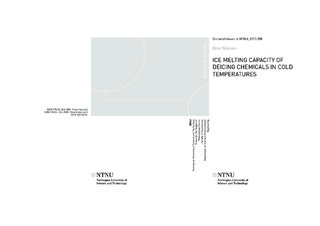| dc.description.abstract | Cold climates cause a great number of challenges when it comes to maintaining road conditions. For instance, snowstorms, frost and ice can all create slippery and even impassible roads. Therefore, in order to ensure vehicular mobility and general road safety, winter road maintenance requires the use of plowing and applying sand or various chemicals.
Regarding the latter method, chemicals are applied to weaken bonds in snow and ice, melt snow and ice or prevent ice from forming on the road. A deicing chemical must thus comprise several important elements, one very important element being its ability to melt snow and ice, which is also called its ice melting capacity.
Therefore in order to be able to compare and choose the proper deicing product, it is essential that one is knowledgeable about its ice melting capacity. There have been concerns for many years that the standardized method for measuring ice melting capacity, SHRP H-205.1 for solid and H-205.2 for liquid chemicals, is not reproducible or reliable enough for research purposes. The work performed and outlined in this particular dissertation involves a) a literature review of existing ice melting capacity tests with calculations to determine their accuracy, b) an explanation as to how ice melting capacity can be calculated if the applied chemical has a known phase diagram, c) the development of a new test method for measuring ice melting capacity and determination of equilibrium concentration of deicers, and d) measurements of the ice melting capacity of common deicers in cold temperatures.
It was confirmed that the “SHRP tests” are not accurate enough for research purpose. A new method based on calorimetry, “the calorimeter” was created, and a custom-made calorimeter was built for the research purposes. The idea behind the calorimeter was to measure the amount of energy needed to prevent temperature drop when deicing chemicals are added to ice; this reading can then be used to calculate the amount of melted ice. The calorimeter showed a great improvement in accuracy compared to earlier test methods. It was able to produce accurate results for solutions in cold temperatures; between -0.001g to 0.016g, which is an absolute error from 97% to 115% and an average error of 4%. The calorimeter was used to study the ice melting capacity of NaCl, MgCl2, CaCl2, CMA, KFo and sugar, both as individual chemicals and as additives to NaCl at -18°C. The test revealed the huge difference in melting capacity between solid and liquid chemicals (solutions). The ice melting capacity of the solutions was only 3% – 10% of the solid ice melting capacity. Moreover, out of all the tested chemicals, brine (23% NaCl solution) had the lowest melting capacity except for sugar, which froze at -18°C. However, in a solid state NaCl was the chemical having the highest ice melting capacity, performing 31% better than the chemical coming in second place, calcium chloride (CaCl2-2H2O). Further, as an example, the results were used to calculate application rates for a thin ice layer (0.1mm) at -18°C. The application rate using solid NaCl was within normal ranges, about 30g/m2. However, it was unrealistically high when using solutions. Using MgCl2, CaCl2, CMA, KFo or sugar as additives to NaCl in a solid state decreased the ice melting capacity of NaCl. Using chloride solutions (MgCl2 and CaCl2) as additives to brine resulted in a melting capacity between the melting capacity of the components, the improvement was dependent on the amount of MgCl2 or CaCl2. However, different results were produced by using KFo and CMA; KFo had a destructive influence on the ice melting capacity when mixed with brine, while CMA produced higher ice melting capacity than what the two components had individually. Nonetheless, the ice melting capacity was still very low.
The general conclusions of salting roads in cold temperatures, are that it is possible to achieve sufficient ice melting capacity using solid NaCl at -18°C. Used as solid, NaCl actually have relative high ice melting capacity compared to other commonly used deicers. The general conception of NaCl being “ineffective” when it is cold, must come from other qualities, e.q., low ice melting rate. Therefor, more knowledge is needed to be able to optimize the use of salt when it is cold. With temperatures below eutectic point of NaCl (-21.1°C), is the ice melting capacity of NaCl zero and should not be used. The best strategy is to dry up the road in advance to this temperature, but if the chemicals are needed the results in this dissertation implies that solid CaCl2 or KFo would be the best replacement for NaCl. If solutions are the only option (e.q., impossible to get the solid salt to lay on the road), calculations in this dissertation show that using the right concentration of solutions is crucial. With maximum solubility of MgCl2 and CaCl2 solutions, the application rate for achieving sufficient ice melting capacity in cold temperatures on a thin ice layer is approximately 150 g/m2 at -18°C, in comparison using a 20% MgCl2 and a 25% CaCl2 solution gives extreme application rates of 550 and 400g/m2. | nb_NO |
